What are the prospects for spraying using drones in the UK?
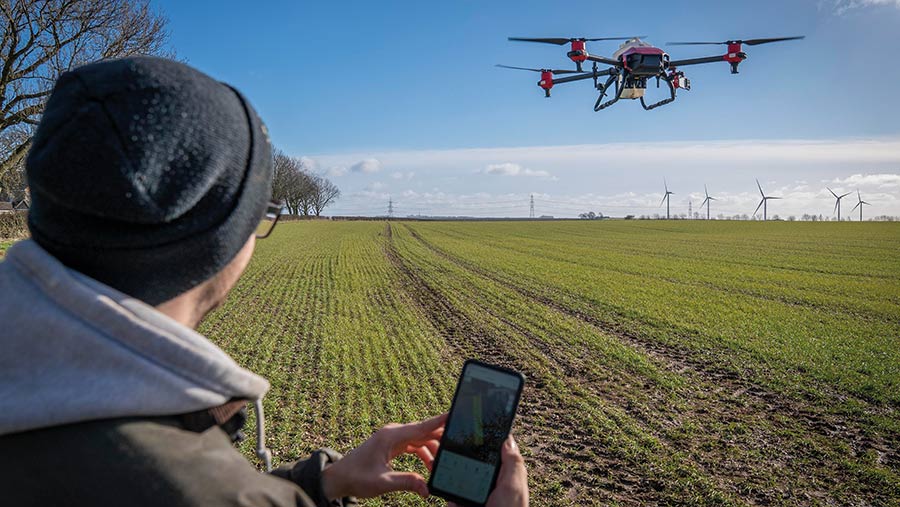 © Autonomous Spray Systems
© Autonomous Spray Systems Imagine waking up in the morning, looking at your phone and finding a report saying blight risk in your potato fields had risen to a level requiring treatment, so your fleet of drones had sprayed those fields in perfect conditions overnight.
While it might sound implausible currently, according to Autonomous Spray Systems chief executive officer Rob Pearson, it could be a reality in just five years’ time – albeit with several hurdles to clear before it can legally happen in the UK.
See also: How to improve consistency with foliar nitrogen sprays
The first big barrier has been cleared, with Mr Pearson’s company recently receiving the first permit in the UK for commercial drone-spraying for drones weighing more than 25kg.
“We now have operational authority for commercial drone applications in agricultural settings.
“As a result, there is a legal pathway for farmers to be trained to become spray drone operators,” says Mr Pearson.
Training takes five days, with courses offered by Harper Adams University.
More courses are rolling out in other leading agricultural universities and colleges over the next few months.
But while the permit allows trained pilots to spread untreated seed and fertilisers, or spray organic products, fertilisers and biostimulants, it does not yet allow pesticides.
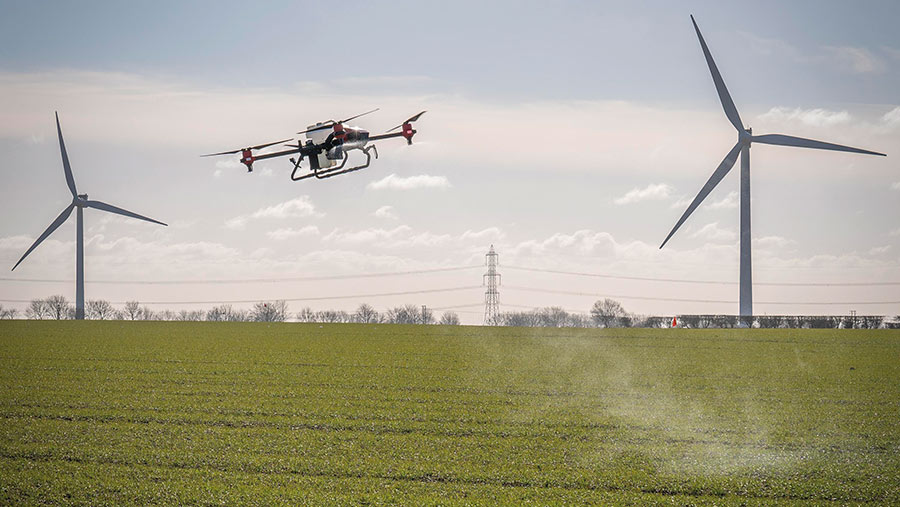
© Autonomous Spray Systems
Lack of data
There is a lack of data for approved products about whether the risks from drone-spraying significantly differs from ground-based techniques, particularly regarding human and environmental exposure, spray drift and efficacy.
If risk is found to be significantly different, it could mean pesticide manufacturers needing to provide extra data to enable drone-spraying authorisations on the product label.
While data in most of those areas are limited – despite legal commercial drone-spraying in Australia, China, South America, US, Africa and Ukraine – there are efforts both in the UK and elsewhere to answer these questions.
Drift research, for example, is ongoing separately by the United States Department of Agriculture (USDA) and the Unmanned Aerial Pesticide Application System Task Force – a coalition of various pesticide manufacturers – as well as the Silsoe Spray Applications Unit in the UK.
The Health & Safety Executive (HSE) has been keen to help navigate the complicated world of pesticide approval, Mr Pearson says, encouraged by a government wanting to accelerate the use of commercial drones (see box).
In numbers
Potential drone impact in UK (all sectors)
- £45bn Drone contribution to economy
- £22bn Net cost savings through use of drones
- 900,000 Drones operating in UK skies by 2030
- 2.4m tonnes Carbon savings
- 650,000 Jobs created
Source: PwC Skies without limits v2.0 report 2022
Two Chinese drone brands currently dominate the agricultural market: XAG and DJI. Both have models capable of holding about 40 litres of product in the XAG P100 and DJI T40, although the latter is not yet available in Europe.
They also have smaller 10-16 litre drones in the XAG V40 and DJI T10. Prices range from about £15,000 for the smaller drones, up to £25,000-£35,000 for the larger units.
The XAG drones are fitted with rotary atomiser nozzles, while DJI has used flat fans in the past.
The new DJI T40 has rotary atomisers, suggesting that might become the preferred option.
Rotary atomiser nozzles offer a bit more flexibility and consistency, suggests Tom Wolf, a Canadian with 33 years’ research experience with spray applications.
“A rotary atomiser determines its droplet diameter from the rotational speed of the atomiser,” he says.
“You can have a wide range of flow rates that generate the same droplet size, which a hydraulic nozzle can’t do that, so we have more consistency of droplet size.”
Why is drift not the same with a drone?
Drift from drone spraying is likely to have different characteristics to that from ground-based sprayer or even planes, says Tom Wolf.
From an aircraft, the spray forms a plume behind the sprayer at over 100m, which is subject to displacement by wind.
“Drones are different. They’re at the transitional point of free flight and hovering at the speed they fly at.
“The downwash from the propellers they generate is actually a kind of air-assist, pushing the spray down into the canopy.”
The strength and persistence of that downwash is key to determining whether the droplets land and hit the ground quickly or rebound or curl up, he says.
“From our observations, we’ve seen every conceivable behaviour of droplets from drones – from no observable drift to a flare that goes back above the drone’s flying height and lots of sideways movement.”
He says the question is can we characterise that? “Is it the weight of the drone, the speed, the flying height, the water volume?”
Current research suggests there is a diverse range of outcomes, nowhere near as predictable as from a ground sprayer.
Part of the reason is there are lots of confounding variables when using a drone, Dr Wolf explains.
“All the rotors are individually run, rotate different ways, and the rotational velocity is adjusted constantly to maintain the position of the drone.
“If there is a gust of wind, it will increase the downwash of some but not all the rotors, so you have a continuously variable flow field beneath the drone.”
The drone’s weight will also change as the spray tank is emptied, which could change the amount of downwash needed to keep the drone aloft.
This, again, will change the flow field under the drone and the behaviour of the droplets.
“We need to figure out if that is important – do you need to change the height to keep drift constant. There’s a lot of things we need to still understand.”
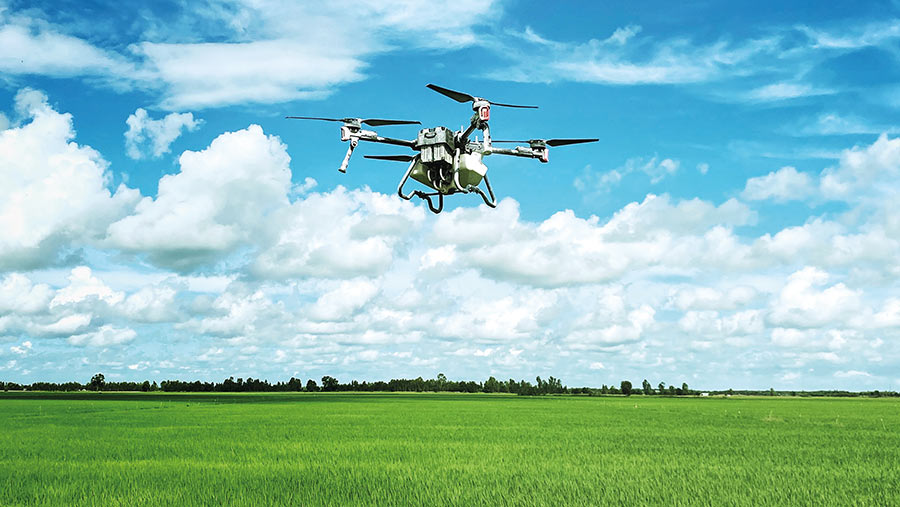
© Vertinetik
Bracken control
The likely first approvals in the UK will be for bracken control, says Mr Pearson.
“There’s been a 400% increase in bracken growth in the past two years, according to the National Trust, and they’re desperate.”
Bracken control is one of the few aerial pesticide applications still approved in the UK through an emergency authorisation using helicopters, but Mr Pearson says it is more typically carried out with a knapsack.
“You might be able to spray a hectare a day on rough terrain with a knapsack, while we could spray a hectare in 10 minutes from the comfort of a vehicle.”
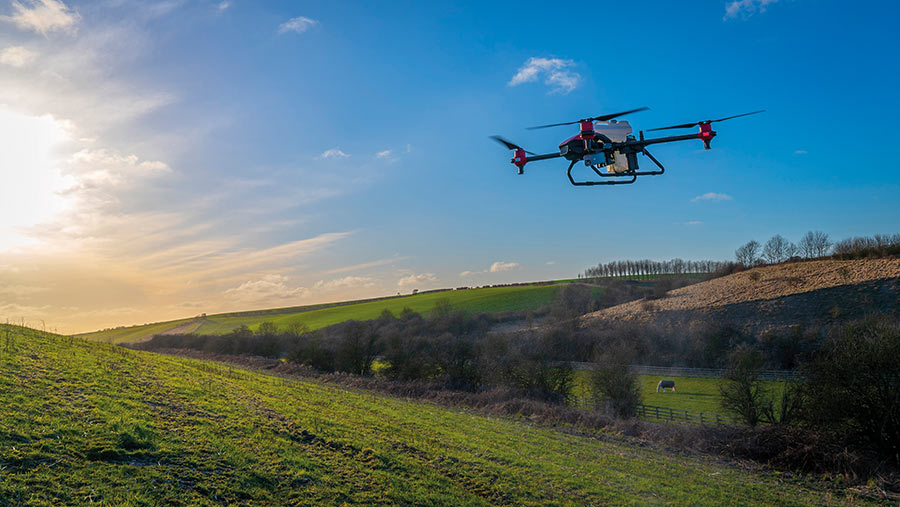
Drones are useful for spraying hard-to-access areas © Autonomous Spray Systems
Drone agency Vertinetik, which helps farmers capture data and plan drone applications, has been working with the Agri-EPI Centre to explore the potential of using drones in the UK.
Vertinetik’s co-founder, Kalique Dugarte, says spraying hard-to-access locations or when ground is not suitable for travel by ground sprayer are two of the potential benefits of using drones.
Another benefit could be spraying tall crops late in the season when ground sprayers can cause crop damage.
Mr Dugarte’s working with a maize grower where late fertiliser applications have added 1t/ha to yield from a rescheduled programme.
“Drones can be a game-changer,” he says.
But perhaps of most interest to growers are the potential benefits in reducing inputs, water and emissions associated with spraying.
Unfortunately, at least to begin with, those benefits are less likely in the UK, Mr Pearson suggests.
“The first step is to spray the chemicals in the same water volumes and concentrations as today, because reformulating and relabelling by manufacturers will take some time.”
Ultimately, he believes reduced water and input rates will be changed on labels. That, together with autonomous swarm flying, might be the step that takes drones from a niche product to mainstream, he forecasts.
“We are heading towards an autonomous future where drones will be an important part on many farms.
“The next three years will prove the safety and reliability of drones, and we are working to prove you don’t need an operator, as autonomous flying will be both safer and more reliable,” he concludes.
Potential benefits of drone spraying
- Use in hard-to-access locations
- Cheaper technology than ground sprayers
- Decreased crop damage and applications costs
- Decreased operator exposure
- Enabling digital and precision tools for targeted and optimised applications
- New business opportunities such as spray-as-a-service
- Input, water and emissions reductions
- Improved soil health from reducing compaction
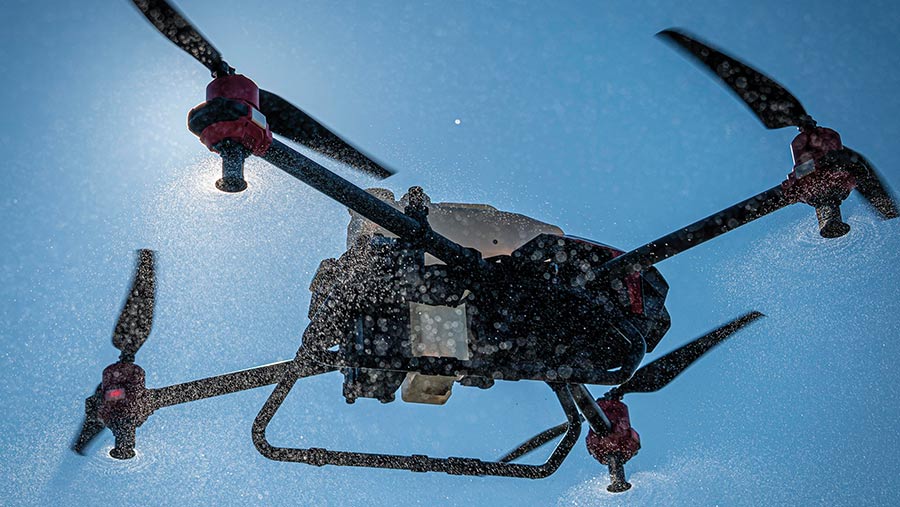
Work is looking at spray drift from drones © Autonomous Spray Systems

